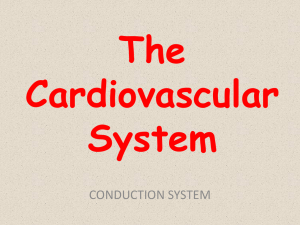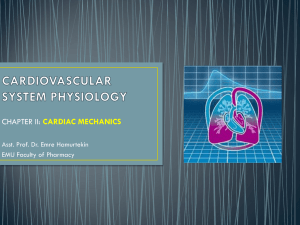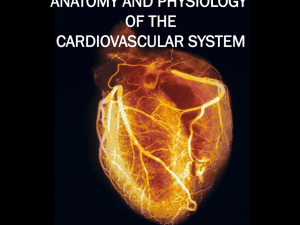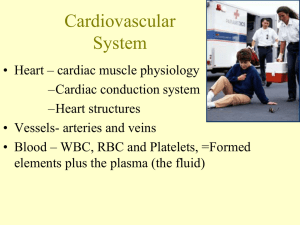Chapter 14b
advertisement
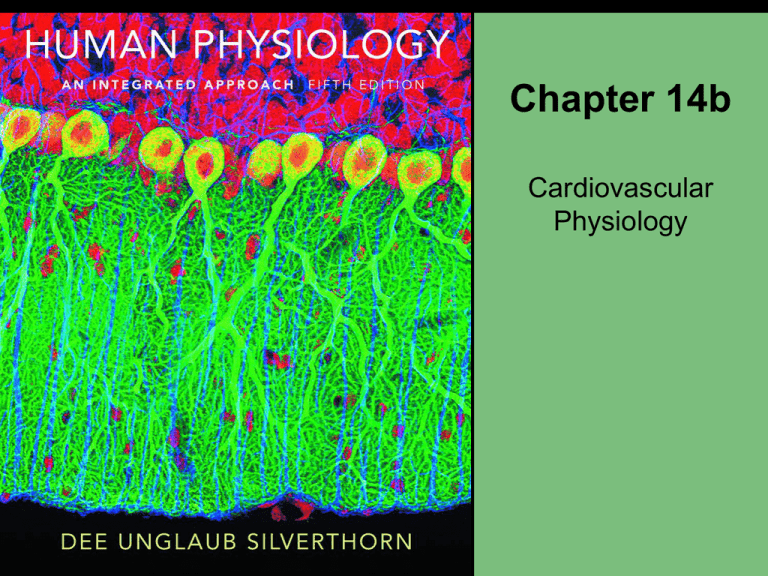
Chapter 14b Cardiovascular Physiology Action Potentials in Cardiac Autorhythmic Cells • • • • Pacemaker potential - no resting -60mV drifts to -40 to action potential Spread through connections to contractile fibers If channels are permeable to both K+ and Na+ 20 Ca2+ channels close, K+ channels open Membrane potential (mV) 0 Ca2+ in K+ out –20 –40 Lots of Ca2+ channels open Threshold Some Ca2+ channels open, If channels close Ca2+ in –60 Net Na+ in Pacemaker potential If channels open Action potential Time (a) The pacemaker potential gradually becomes less negative until it reaches threshold, triggering an action potential. Time (b) Ion movements during an action and pacemaker potential If channels open K+ channels close Time (c) State of various ion channels Figure 14-15 Action Potentials in Cardiac Autorhythmic Cells PLAY Interactive Physiology® Animation: Cardiovascular System: Cardiac Action Potential Sympathetic stimulation Normal Membrane potential (mV) Membrane potential (mV) Modulation of Heart Rate by the Autonomic Nervous System 20 0 –20 –40 –60 Depolarized Normal 0 –60 More rapid depolarization 0.8 1.6 Hyperpolarized 2.4 Slower depolarization 0.8 Time (sec) (a) Parasympathetic stimulation 20 1.6 2.4 Time (sec) (b) Figure 14-16 Action Potentials Table 14-3 Electrical Conduction in Myocardial Cells Membrane potential of autorhythmic cell Membrane potential of contractile cell Cells of SA node Contractile cell Intercalated disk with gap junctions Depolarizations of autorhythmic cells rapidly spread to adjacent contractile cells through gap junctions. Figure 14-17 Electrical Conduction in the Heart 1 1 SA node depolarizes. SA node AV node 2 Electrical activity goes rapidly to AV node via internodal pathways. 2 3 Depolarization spreads more slowly across atria. Conduction slows through AV node. THE CONDUCTING SYSTEM OF THE HEART SA node 3 Internodal pathways 4 Depolarization moves rapidly through ventricular conducting system to the apex of the heart. 5 Depolarization wave spreads upward from the apex. AV node 4 AV bundle Bundle branches Purkinje fibers 5 Figure 14-18 Electrical Conduction • SA node • Sets the pace of the heartbeat at 70 bpm • AV node (50 bpm) and Purkinje fibers (25-40 bpm) can act as pacemakers under some conditions • AV node • Routes the direction of electrical signals • Delays the transmission of action potentials Einthoven’s Triangle Right arm Left arm I Electrodes are attached to the skin surface. II III A lead consists of two electrodes, one positive and one negative. Left leg Figure 14-19 The Electrocardiogram • Three major waves: P wave, QRS complex, and T wave Figure 14-20 Electrical Activity • Correlation between an ECG and electrical events in the heart P wave: atrial depolarization START P The end R P PQ or PR segment: conduction through AV node and AV bundle T P Q S Atria contract T wave: ventricular repolarization Repolarization R ELECTRICAL EVENTS OF THE CARDIAC CYCLE T P Q S P ST segment Q wave Q R R wave P R Q S R Ventricles contract P Q S wave P Q S Figure 14-21 Electrical Activity START P wave: atrial depolarization P The end R P PQ or PR segment: conduction through AV node and AV bundle T P QS Atria contract T wave: ventricular repolarization R T P Repolarization ELECTRICAL EVENTS OF THE CARDIAC CYCLE QS P ST segment R Q wave Q R wave R P QS R Ventricles contract P Q P S wave QS Figure 14-21 (9 of 9) Electrical Activity • Comparison of an ECG and a myocardial action potential 1 mV 1 sec (a) The electrocardiogram represents the summed electrical activity of all cells recorded from the surface of the body. 110 mV 1 sec (b) The ventricular action potential is recorded from a single cell using an intracellular electrode. Notice that the voltage change is much greater when recorded intracellularly. Figure 14-22 Electrical Activity • Normal and abnormal electrocardiograms Figure 14-23 Mechanical Events • Mechanical events of the cardiac cycle 1 Late diastole—both sets of chambers are relaxed and ventricles fill passively. START 5 Isovolumic ventricular relaxation—as ventricles relax, pressure in ventricles falls, blood flows back into cusps of semilunar valves and snaps them closed. 2 Atrial systole—atrial contraction forces a small amount of additional blood into ventricles. 3 Isovolumic ventricular contraction—first phase of ventricular contraction pushes AV valves closed but does not create enough pressure to open semilunar valves. S1 S2 4 Ventricular ejection— as ventricular pressure rises and exceeds pressure in the arteries, the semilunar valves open and blood is ejected. Figure 14-24 Cardiac Cycle PLAY Interactive Physiology® Animation: Cardiovascular System: Cardiac Cycle Cardiac Cycle • Left ventricular pressure-volume changes during one cardiac cycle Stroke volume 120 Left ventricular pressure (mmHg) KEY EDV = End-diastolic volume ESV = End-systolic volume ESV D 80 C One cardiac cycle 40 B EDV A 0 65 100 Left ventricular volume (mL) 135 Figure 14-25 Wiggers Diagram Time (msec) 0 Electrocardiogram (ECG) 100 200 300 400 500 600 700 800 QRS complex QRS complex P T P 120 B 90 Pressure (mm Hg) Dicrotic notch A 60 Left venticular pressure 30 Left atrial pressure 0 D C S1 Heart sounds 135 S2 E Left ventricular volume (mL) F 65 Atrial systole Atrial systole Ventricular systole Ventricular diastole Isovolumic Ventricular Early Late ventricular systole ventricular ventricular contraction diastole diastole Atrial systole Atrial systole Figure 14-26 Wiggers Diagram Time (msec) 0 Electrocardiogram (ECG) 100 200 300 400 500 600 700 800 QRS complex QRS complex P T P 120 B 90 Dicrotic notch A Pressure (mm Hg) 60 Left venticular pressure 30 Left atrial pressure 0 D C S1 Heart sounds 135 S2 E Left ventricular volume (mL) F 65 Atrial systole Atrial systole Ventricular systole Ventricular diastole Isovolumic Ventricular Early Late ventricular systole ventricular ventricular contraction diastole diastole Atrial systole Atrial systole Figure 14-26 (13 of 13) Stroke Volume and Cardiac Output • Stroke volume • Amount of blood pumped by one ventricle during a contraction • EDV – ESV = stroke volume • Cardiac output • Volume of blood pumped by one ventricle in a given period of time • CO = HR SV • Average = 5 L/min Autonomic Neurotransmitters Alter Heart Rate KEY Integrating center Cardiovascular control center in medulla oblongata Efferent path Effector Tissue response Sympathetic neurons (NE) Parasympathetic neurons (Ach) 1-receptors of autorhythmic cells Muscarinic receptors of autorhythmic cells Na+ and Ca2+ influx K+ efflux; Ca2+ influx Rate of depolarization Hyperpolarizes cell and rate of depolarization Heart rate Heart rate Figure 14-27 Stroke Volume • Frank-Starling law states • Stroke volume increase as EDV (ending diastolic volume) increases – stretch -> more force • EDV is affected by venous return • Venous return is affected by • Skeletal muscle pump • Respiratory pump • Sympathetic innervation of vessels • Force of contraction is affected by • Stroke volume • Length of muscle fiber and contractility of heart Stroke Volume • Length-force relationships in intact heart: a Starling curve Figure 14-28 Inotropic Effect • The effect of norepinepherine on contractility of the heart Figure 14-29 Cardiac Output PLAY Interactive Physiology® Animation: Cardiovascular System: Cardiac Output Catecholamines Modulate Cardiac Contraction Epinephrine and norepinephrine bind to 1-receptors that activate cAMP second messenger system resulting in phosphorylation of Voltage-gated Ca2+ channels Phospholamban Open time increases Ca2+-ATPase on SR Ca2+ entry from ECF KEY Ca2+ stores in SR Ca2+ released Ca2+ removed from cytosol faster Shortens Ca-troponin binding time SR = Sarcoplasmic reticulum ECF = Extracelllular fluid More forceful contraction Shorter duration of contraction Figure 14-30 Stroke Volume and Heart Rate Determine Cardiac Output CARDIAC OUTPUT is a function of Heart rate Stroke volume determined by determined by Rate of depolarization in autorhythmic cells Force of contraction in ventricular myocardium is influenced by Decreases Due to parasympathetic innervation Increases increases Contractility Sympathetic innervation and epinephrine increases End-diastolic volume which varies with Venous constriction Venous return aided by Skeletal muscle pump Respiratory pump Figure 14-31 Summary • Cardiovascular system—anatomy review • Pressure, volume, flow, and resistance • Pressure gradient, driving pressure, resistance, viscosity, flow rate, and velocity of flow • Cardiac muscle and the heart • Myocardium, autorhythmic cells, intercalated disks, pacemaker potential, and If channels • The heart as a pump • SA node, AV node, AV bundle, bundle branches, and Purkinje fibers Summary • The heart as a pump (continued) • ECG, P wave, QRS complex, and T wave • The cardiac cycle • Systole, diastole, AV valves, first heart sound, isovolumic ventricular contraction, semilunar valves, second heart sound, and stroke volume • Cardiac output • Frank-Starling law, EDV, preload, contractility, inotropic effect, afterload, and ejection fraction

![Cardio Review 4 Quince [CAPT],Joan,Juliet](http://s2.studylib.net/store/data/005719604_1-e21fbd83f7c61c5668353826e4debbb3-300x300.png)
